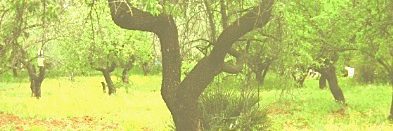Sometimes a failure turns out to be a blessing. I am speaking of Park Güell, which was conceived by its entrepreneur-owner as a gated forest community for the Barcelona wealthy at the end of the 1800s. Had the enterprise succeeded, Barcelona would not now have one of its greatest draws, not to mention a wonderfully forested mountain park with the eccentric flourishes of Antoni Gaudí, open to the general public. Rather fortuitously, only two mansions were ever built on the site: only one paid for; the other became Gaudí’s home. And that was the object of our visit on our last day in Barcelona.
I appreciated seeing in what surroundings Gaudí lived. Simple and frugal. I loved that the few furnishings he had did not have the excessive ornamentation that are the hallmarks of his designs: a rather interesting dichotomy and thoroughly logical and understandable. One detail stood out about his personal preferences. The nuns who took care of his needs, after his housemates (his father and niece) had died, took note that his clothes were mended and patched multiple times. This reminded me of my friend Okuyama-san who could not bear to discard torn well-made clothing, and this personal fact further endeared Gaudí to me.
The house’s tall, narrow windows, strategically placed, looked out onto the trees and woods that surround it. It must have been such a haven and inspiration, as it was to me, just from that brief visit. Music from local buskers at obscured locations in the park enhanced the magical atmosphere: a trio of flamenco guitarists and a male flamenco dancer, and just wafting out from the shade, engaging variations on Pachelbel’s Canon as we exited.
We next headed for Sant Antoni Market, remembering that we had had an excellent meal inside many years ago. It was closed, being a Sunday, but we wondered around, and astonishingly, the majority of inhabitants that we met looked Filipino. We spied a small diner called Myramar, and approaching its posted offerings, saw puto and lechon kawali and other familiar Filipino dishes. Well, that day’s lunch was decided. It was indeed a local hang-out, and it was buzzing with a birthday celebration ongoing. We took one of the last tables available. Lechon kawali (crisp fried pork cubes), sinigang (sour soup), and pinakbet (braised tropical vegetables) were some of their specialties. Haute cuisine it was not, but it was honest, comforting home cooking. As it was a Sunday, they didn’t have one of my faves – adobong pusit (squid adobo-style). Pity. And for dessert, there was no puto (steamed rice muffins) or buko pandan (young coconut and pandan-flavoured jelly) either. Oh, and when a Filipino says the rice serving is small, remember that “small,” to a confirmed rice-eater, is relative. We could have done with just one order of rice, and we would still have had some left over. Nevertheless, it was a comforting reminder of home.
In the same neighbourhood is Barcelona’s Museum of Contemporary Culture (Centre de Cultura Contemporània de Barcelona, CCCB), and what I love about it is that on Sunday afternoons from 3 pm, admission is free. (We didn’t know this beforehand.) What a great way to develop ordinary people’s aesthetic and cultural sensibilities! There was a multimedia glass-enclosed library on the ground floor, with what appeared to be inviting upholstered cubes in nooks to sit or lie on, as the mood takes you. And there were young people there, clearly enjoying themselves, relaxed and lounging with headphones and laptops. No cautionary “Keep your feet off the seats” signs, as the seating cubes were clearly intended for total relaxation.
I was very much drawn to the current exhibition of Antoni Arissa’s black-and-white photographs titled “The Shadow and the Photographer,” featuring local people in the early 1900s as they went about their daily life and scenes from the community. Long forgotten, Arissa’s work has been recently unearthed from archived negatives and printed as Arissa would have done them in his time (he was also a printer). This exhibition is one of the museum’s projects of bringing to the public the brilliant work of unsung Catalan artists.
A satisfying day in all the senses – a walk accompanied by snatches of music in the shaded woods of Park Güell, a visit to GaudÍ’s simple and serene home, Filipino comfort food, and seeing light and shadows through the eyes of Catalan photographer Antoni Arissa. As we left, Filipino teens were practising a choreographed performance surrounded by the charmingly painted and decorated walls of the open atrium of the museum. Lovely!
We arrived in Bonn well past 1 am. Travelling and discovering new places and having adventures are nice, but coming home is even nicer.

